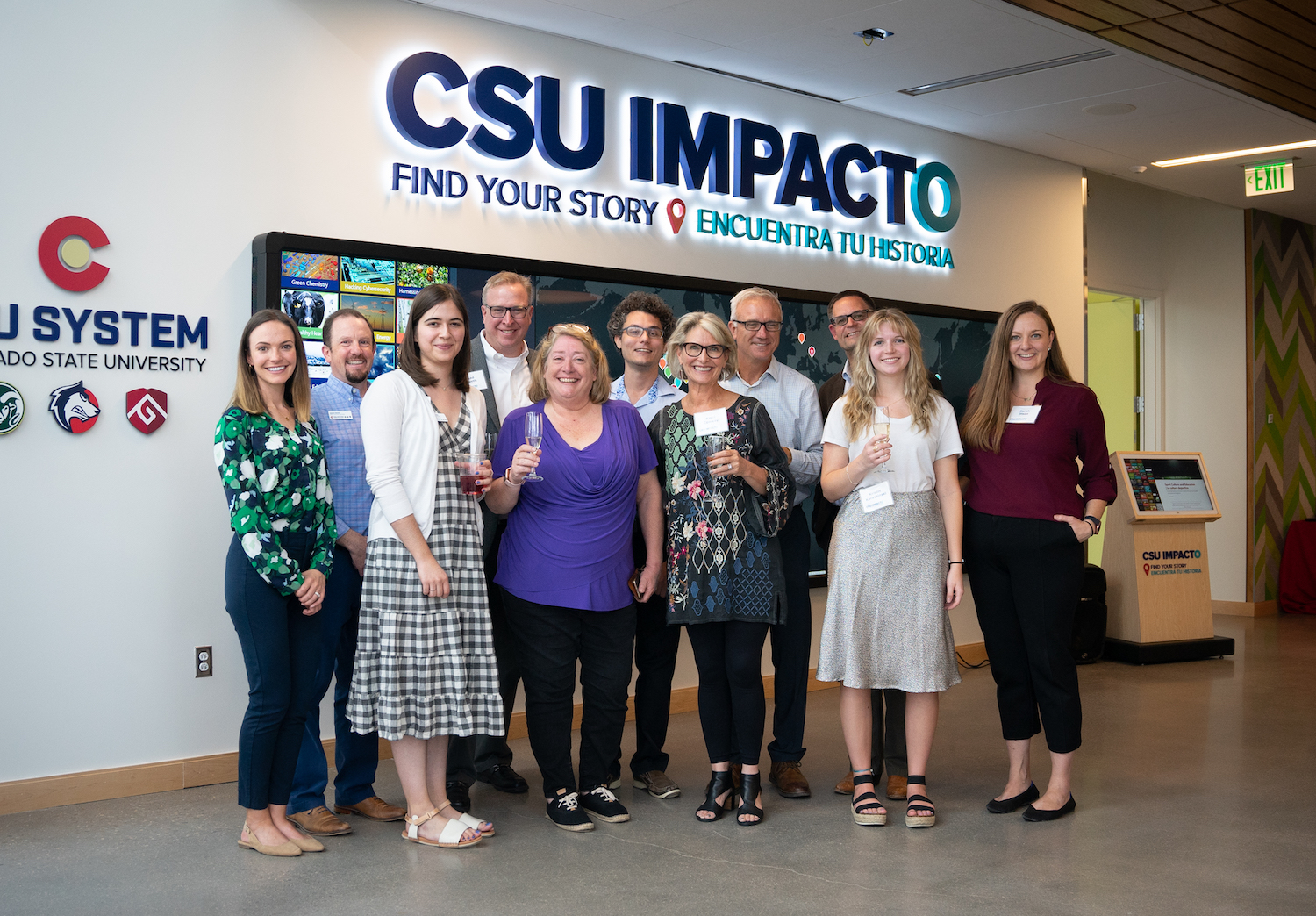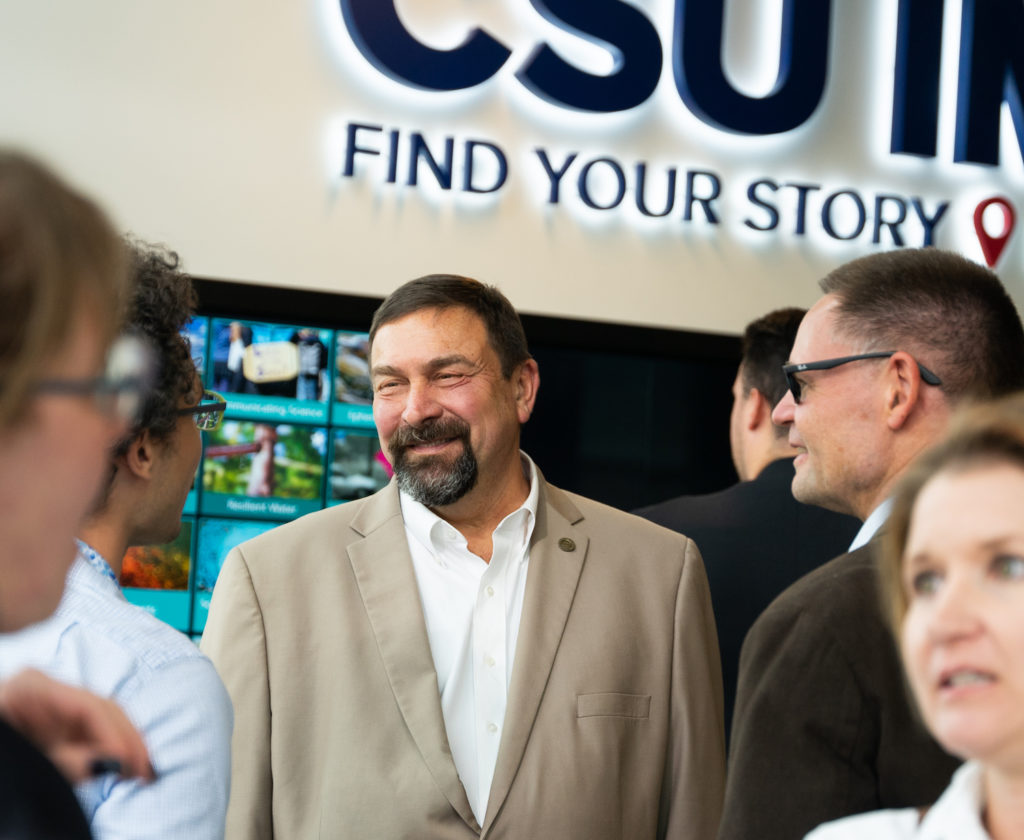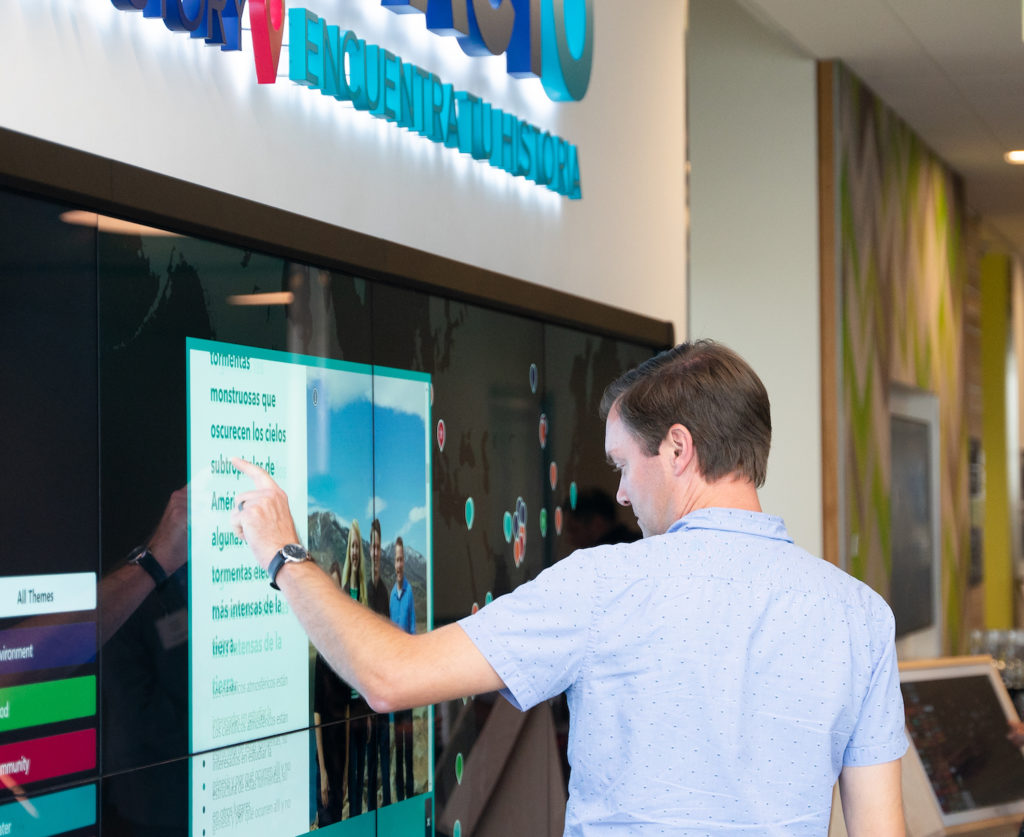
The CSU Impact(o) team in front of the global map during the grand opening event on Sept. 27.
One of the stories portrayed on the Impact Map at CSU Spur describes the efforts of a research team led by Stephanie Kampf, a Colorado State University professor of ecosystem science and sustainability, to track the flow of water in small, and sometimes dry, headwater streams.
The Stream Tracker project emerged out of work forecasting the flow of streams feeding the Cache la Poudre River on the slopes west of Fort Collins. Now, with help from hundreds of smartphone-wielding citizen scientists from around the world, it is providing insight on the frequency with which water runs in streambeds across the United States and in such countries as Japan, Lebanon, and Spain.
This project is one of 80 initiatives currently portrayed on the CSU System’s Impact Map, and its technology-enabled progression from a regional focus toward global insight roughly mirrors the journey users take when interacting with the new exhibit on the third floor of the Spur campus’s Terra building.
The CSU Impact Map—or Impacto, in Spanish—provides a glimpse of the System’s global reach while providing a chance for users to explore specific ways CSU System faculty, staff, students, and alumni are working to solve problems, support communities and create impact in far-flung corners of the world.
CSU System Chancellor Tony Frank, speaking at a recent event recognizing the team that produced the map, described the vision behind the Global Mapping and Strategic Outreach project.
“We want people to walk up to this map, see someone doing something that is inspirational, and say, Maybe I can do that. I can do that. I’m going to do that,” Frank said. “Some of those people will get that inspiration and get their start right here at this wall, and they will be the next generation of people who will tell the stories, and about whom those stories will be told.”


Left: Chancellor Tony Frank interacts with guests during the grand opening event for CSU Impact(o). Right: A visitor interacts with the global map.
The map’s main display is 17-feet wide and five feet tall. It is made up of four high-resolution touch screen panels that, like smartphones, respond to the swipe of a single finger or the combined input of fingertips converging or spreading. Users can zoom in and navigate across continents studded with color-coded pins marking research or project sites, or they can delve into such themes as the environment, food, community, water, health, and energy. Stories, accessed by pressing on individual pins or selecting from a menu on the display’s left side, include text in English and Spanish, photographs, and, in many cases, videos and other elements.
Kampf’s project on “Ephemeral Streams” is one of 11 water-focused stories appearing on the map. In the food category, one story focuses on adaptations to climate and environmental changes in a region stretching on five countries in southern Africa, and another describes efforts improve nutrition in Ecuadorian communities that have shifted away from traditional diets. One community story involves work organizing campaigns to prevent human trafficking and build awareness about its prevalence, and yet another describes a project that offers cultural immersion experiences for student athletes.
Kerri Conway, special advisor to the chancellor and director of international agriculture at CSU Spur, said the range of stories now displayed on the map represents just the first step in an evolving effort that will broaden to include, among other things, many more stories of alumni who came to study at CSU System campuses from across the country and the globe, and who are now working to address the world’s pressing challenges. The power of career paths is part of the learning experience found in the exhibit and global map.
“One of the big questions guiding this work is this: where is our value add?” Conway said. “By answering that question in a dramatic and engaging way, we are hoping to build on the CSU System’s momentum as a force for positive global change.”
In addition to the main display, the Terra building holds two kiosks that offer touch-screen access to CSU Impact Map materials. Additional information about the CSU Impact(o) project and a link to access a virtual version of the map are available at csuspur.org/csu-impacto.
The team that produced the map included CSU and System administrators, faculty, and students. Emily Amedée, content manager for the project, created most of the content included on the map. Greg Newman, a research scientist at CSU’s Natural Resource Ecology Laboratory who is also coordinator for engagement technology as CSU Spur, and Brandon Budnicki, a CSU graduate student working with Newman, took the lead shaping and refining the interface that allows users to find and experience that content.
“This technology helps tell a story, and it tells it in a really compelling way.” Frank said. “Whenever we can connect people across the planet to talk about ways people are coming together to make a difference, we make progress and move things forward.”
The CSU Spur campus is open and free to the public from 9 a.m. to 5 p.m. Monday-Friday and every 2nd Saturday of the month from 10 a.m. to 3 p.m. For additional information on what to expect as a visitor to CSU Spur, visit CSUSpur.org.
About CSU Spur
CSU Spur is a new, free educational year-round public life-long learning destination in Denver focused on engaging PreK-12 students, families, and visitors around food, water, and health. CSU Spur showcases the work of the CSU System campuses: CSU, CSU Pueblo, and CSU Global, and offers degree programs that originate from the campus offerings. Spur is built upon the land-grant mission of access to education and the belief that students can be anything they want to be. To inspire learners of all ages to engage in important world issues, CSU Spur brings together scientists to collaborate, puts science on-display, and showcases career paths. The CSU Spur campus provides immersive learning experiences and cutting-edge research across three buildings: Vida, Terra, and Hydro. Learn more at CSUSpur.org.